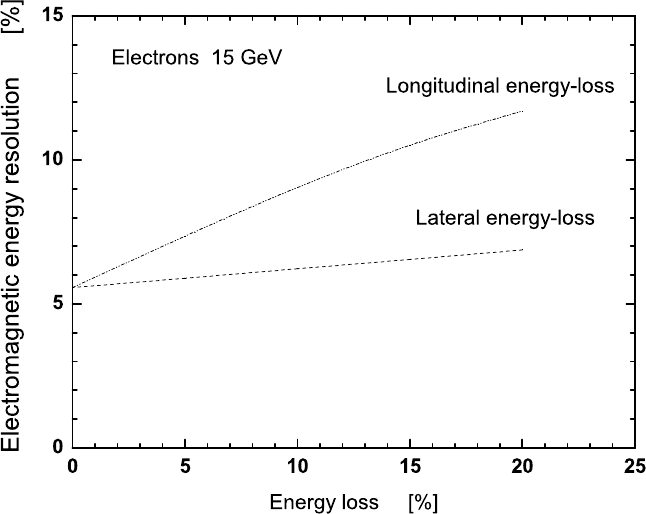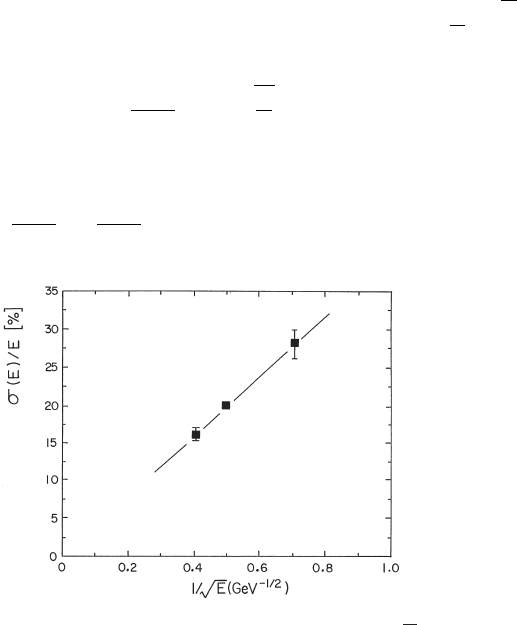Leroy C., Rancoita P.-G. Principles Of Radiation Interaction In Matter And Detection
Подождите немного. Документ загружается.


January 9, 2009 10:21 World Scientific Book - 9.75in x 6.5in ws-bo ok975x65˙n˙2nd˙Ed
650 Principles of Radiation Interaction in Matter and Detection
Fig. 9.15 Energy resolution, σ(E) /E in %, measured as a function of the fraction in % of
lateral and longitudinal deposited-energy losses (curves from [Amaldi (1981)], see also [Leroy and
Rancoita (2000)]) for the marble calorimeter of CHARM Collaboration [Diddens et al. (1980)].
9.4.2 Effect of Limited Containment on Energy Resolution
So far in the previous sections, the energy resolution of the calorimeter was con-
sidered for negligible lateral and longitudinal visible-energy losses, namely for the
case where the calorimeter longitudinal depth and lateral width are large enough
to contain the shower cascade completely. However, the energy resolution expressed
by Eq. (9.24) is degraded by the effects of the finite dimensions of the calorimeter.
The energy resolution is increased by leakage fluctuations caused by longitudinal,
E
L
, and lateral, E
l
, energy-losses. The size of these losses depends on the dimen-
sions of the calorimeter. The longitudinal energy-losses display a weak dependence
on the incoming energy and an even weaker dependence on the material. The lon-
gitudinal shower development can be described, as seen for instance in Eq. (2.236),
by a function, whose parameters depend on the incoming energy E as ln E. Thus,
finite dimensions of a calorimeter result in losses of the average dep osited energy
depending on ln E [Engler (1985); Grupen (1996)]. Moreover, because of the statis-
tical nature of the cascade process (including the location of the first interaction of
the primary particle along the shower axis), the finite longitudinal dimension will

January 9, 2009 10:21 World Scientific Book - 9.75in x 6.5in ws-bo ok975x65˙n˙2nd˙Ed
Principles of Particle Energy Determination 651
affect the energy resolution on an event-by-event basis.
The lateral energy-losses do not critically depend on the incoming energy, on the
type of incident particles (electrons or photons), or on the absorber material at a
depth where the cascade is extended over a small transverse distance in units of the
Moli`ere radius. For large transverse distances in units of Moli`ere radius, a slight de-
pendence on the above parameters is related to soft interactions contributing to the
energy deposition process. Fluctuations coming from the transverse leakage come
out to be less effective compared to those caused by the longitudinal leakage [Amaldi
(1981)]. Thus, the longitudinal energy-loss contribution to the degradation of the
energy resolution is expected to be larger than the contribution depending on lateral
energy-losses (see the discussion on the lateral shower development on page 207).
The longitudinal energy leakage can be calculated by integrating one of the equa-
tions given in Sect. 2.4.2.2. Similarly, the lateral energy leakage can be calculated
by integrating one of the equations given in Sect. 2.4.2.3. However, these equa-
tions give the average behavior of the shower development only approximately. In
a sampling calorimeter, because the visible energy is proportional to the incoming
energy [see Eq. (9.1)], the fraction of visible-energy lost laterally or longitudinally
is given by the fraction of the lateral or longitudinal leakage of the incoming energy,
respectively.
As a rule of thumb [Engler (1985)], the deterioration of the energy resolution is
expected to increase proportionally to the longitudinal leakage. These effects were
experimentally investigated. The marble fine-grained calorimeter of the CHARM
Collaboration [Diddens et al. (1980)] was used to determine the effect of lateral
and longitudinal losses. The experimental data allowed Amaldi (1981) to deter-
mine that the longitudinal losses are affecting more the energy resolution than
the lateral losses, as expected (Fig. 9.15). For energy losses lower than 15%, the
calorimeter energy-resolution is almost linearly related to the average fraction in
% of the lateral energy lost (lt = 100 × [E
l
/E]) and of the longitudinal energy lost
(Lg = 100 × [E
L
/E]), according to
σ(E)
E
≈
·
σ(E)
E
¸
0
(1 + 6.6 × 10
−2
Lg), (9.30)
and
σ(E)
E
≈
·
σ(E)
E
¸
0
(1 + 1.4 × 10
−2
lt), (9.31)
where (from Fig. 9.15)
h
σ(E)
E
i
0
≈ 5.58% is the measured calorimeter resolution in
the absence of energy losses.
For highly segmented readout planes such as mosaic planes made of silicon de-
tectors, dead zones between the detectors in the mosaics result in losses of visible
energy, indicated by E
D
. These dead zones can affect the energy resolution [SICAPO
Collab. (1994a)]. In the following, the fraction in % of visible-energy lost by the
mosaic dead zones is indicated by De (i.e., De = 100 × [E
D
/E]). These losses are

January 9, 2009 10:21 World Scientific Book - 9.75in x 6.5in ws-bo ok975x65˙n˙2nd˙Ed
652 Principles of Radiation Interaction in Matter and Detection
subjected to event-by-event fluctuations which are more similar to the longitudinal
energy-losses than to the lateral energy-losses. The dead area energy-losses start
much closer to the impinging point than the lateral energy-losses which appear af-
ter some transverse distance from the impinging point and are controlled by the
Moli`ere radius.
Their effect on the calorimeter energy resolution was investigated as a func-
tion of the incoming electron energy with Fe and Pb passive samplers and em-
ploying the same readout detectors (namely silicon mosaic planes) [SICAPO Col-
lab. (1994a)]. These passive materials have similar Moli`ere radii (≈ 1.8 and 1.6 cm
respectively), and consequently similar values of De. The data were collected for
sampling frequencies τ = 1.99 and 3.98 for Fe absorbers, and τ = 1.96, 2.36, 2.50 and
3.39 for Pb absorbers [SICAPO Collab. (1994a); Furetta et al. (1995)]. In Figs. 9.16
and 9.17, the measured energy-resolutions for the two calorimeters with Fe (and τ
= 1.99) and Pb (and τ = 3.39) absorbers are shown as a function of 1/
√
E. The
experimental data show (in both cases) a linear dependence on 1/
√
E and are in
agreement with
σ(E)
E
= K
le
r
τ
E
. (9.32)
Similarly to the cases of longitudinal and lateral energy-losses, these experimentally
measured energy-resolutions [SICAPO Collab. (1994a)] are consistent with
σ(E)
E
=
·
σ(E)
E
¸
0
[1 + (6.8 ± 1.7) × 10
−2
De], (9.33)
Fig. 9.16 Energy resolution σ(E)/E in % measured as a function of 1/
√
E (E is the incoming
electron energy) for fixed visible-energy losses due to the mosaic structure of the active readout
silicon plane and Fe passive sampler (reprinted from Nucl. Instr. and Meth. in Phys. Res. A 345,
Bosetti, M. et al., Systematic investigation of the electromagnetic energy resolution on sampling
frequency using silicon calorimeters, 244–249, Copyright (1994), with permission from Elsevier,
e.g., for the list of the authors see [SICAPO Collab. (1994a)]; see also [Leroy and Rancoita (2000)]).

January 9, 2009 10:21 World Scientific Book - 9.75in x 6.5in ws-bo ok975x65˙n˙2nd˙Ed
Principles of Particle Energy Determination 653
where
h
σ( E)
E
i
0
is the calorimeter resolution in the absence of energy-losses [e.g., see
Eq. (9.25)], and, thus, can be expressed in a general form by
σ(E)
E
= K[1 + (6.8 ± 1.7) × 10
−2
De]
r
τ
E
. (9.34)
As a consequence, from Eqs. (9.32–9.34) we have that
K
le
= K[1 + (6.8 ± 1.7) × 10
−2
De],
where K is the parameter of the energy resolution, in the absence of dead-area
energy-losses [see Eqs. (9.25, 9.27)]. As expected from Eq. (9.34), the ratio R
K
of
the measured K
le
value for the Fe and Pb calorimeters is R
K
= 28.3/22.2 ≈ 1.27
and is consistent with the value calculated from Table 9.4, i.e., ≈ 1.31, without
energy losses.
The visible-energy losses, due to the leakage of the incoming particle energy,
degrade the calorimeter resolution. In fact, the K
le
values are larger than those
discussed in previous sections on energy resolutions for no dead-area energy-losses.
The multiplicative factor De, appearing in Eqs. (9.33, 9.34), is similar (within the
experimental errors) to the one for longitudinal energy-loss (Lg) given in Eq. (9.30)
since, in both cases, energy losses are subjected to event-to-event fluctuations.
Fig. 9.17 Energy resolution σ(E)/E in % measured as a function of 1/
√
E (E is the incoming
electron energy) for fixed visible-energy losses due to the mosaic structure of the active readout
silicon plane and Pb passive sampler (reprinted from Nucl. Instr. and Meth. in Phys. Res.
A 345, Bosetti, M. et al., Systematic investigation of the electromagnetic energy resolution on
sampling frequency using silicon calorimeters, 244–249, Copyright (1994), with permission from
Elsevier, e.g., for the list of the authors see [SICAPO Collab. (1994a)]; see also [Leroy and Rancoita
(2000)]).
January 9, 2009 10:21 World Scientific Book - 9.75in x 6.5in ws-bo ok975x65˙n˙2nd˙Ed
654 Principles of Radiation Interaction in Matter and Detection
9.5 Homogeneous Calorimeters
9.5.1 General Considerations
A homogeneous calorimeter is a block or a matrix of blocks of sensitive absorbing
material where the energy of an incoming particle is degraded and measured via
the collection of visible photons. The absorbing material or active medium of the
calorimeter is either scintillator, where fluorescence is produced by the passage of
an ionizing particle or material with a high refractive index transparent to the
˘
Cerenkov photons produced by charged particles, which move with a velocity
v = c/n
larger than that of light through the medium of refractive index n > 1 (for a treat-
ment of scintillator detectors see the chapter on Scintillating Media and Scintillator
Detectors, while for a treatment of the
˘
Cerenkov effect see Sect. 2.2.2).
A variety of scintillating and
˘
Cerenkov materials (see the chapter on Scintillating
Media and Scintillator Detectors) can be used as the active medium of homogeneous
calorimeters. The choice of a particular active medium is made with the goal to
achieve the best possible energy and position resolution over an energy range as
large as possible (from MeV up to TeV energies) taking into account practical and
physical requirements.
The energy resolution is determined by the fluctuations in the number of pho-
tons or ions pairs produced by the cascade. The light yield, i.e, the number of
photons produced per MeV of energy deposition, should be large enough to mini-
mize the contribution of the statistical fluctuations to the energy resolution. Typi-
cally, the amount of collected light should exceed 100 γ/MeV and in fact can exceed
4×10
4
γ/MeV for NaI(Tl) (Table 5.2).
The size of the sensitive material length and lateral dimensions are important
constraints. The total length should be sufficiently large to ensure that energy leak-
age of the electromagnetic cascades at the back of the calorimeter is small enough
not to degrade the energy resolution, even for very energetic electrons and pho-
tons. High density sensitive materials have short radiation length and small Moli`ere
radius, so favoring good compactness of the calorimeter.
The length of the sensitive material has also to be compatible with light trans-
mission properties and light attenuation length. The light output along the length
of the crystal should not vary (uniform light collection).
The lateral size of the sensitive material is chosen in such a way that incoming
particles fired centrally into a block at normal incidence deposit a large fraction
between 70 and 80% of their energy in this particular block, while energy deposited
in the neighboring blocks is large enough to measure the coordinates of the center of
gravity and, consequently, of the impact point. This can be achieved by selecting a
material with a small Moli`ere radius (typically ≤ a few cm’s, see Table 5.2) resulting
in narrow cascades and a matrix of sensitive material blocks with the lateral size
of a cell of the order of the Moli`ere radius. However, transverse dimensions of a
January 9, 2009 10:21 World Scientific Book - 9.75in x 6.5in ws-bo ok975x65˙n˙2nd˙Ed
Principles of Particle Energy Determination 655
sensitive block in a matrix result most generally from practical considerations, as
a compromise between the spatial resolution and the number of readout channels
whose number increases fast with the segmentation.
The decay time of scintillation should be as short as possible. This becomes
an important constraint in experiments at the LHC, where the light has to be
collected in less than ∼ 10 ns since the expected LHC interbunch crossing time is
25 ns, requiring the use of new types of crystals such as PbWO
4
.
The readout of the homogeneous calorimeters is realized through photomulti-
plier tubes or photodiodes of various types collecting the produced light. Factors
such as the noise, the quantum efficiency and the gain of the photosensitive device
contribute to the energy resolution of the calorimeter.
In Sect. 9.9, the mechanisms for achieving the compensation in (hadronic)
calorimeters will be described. These mechanisms do not apply to homogeneous
calorimeters. These mechanisms are based on the fact that only a small fraction of
the cascade energy is deposited in the active medium of the calorimeter. Depen-
ding on the nature of the active and passive medium, there are ways to equalize the
calorimeter response to electromagnetic and non-electromagnetic components of the
cascade. In the case of homogeneous calorimeters, there is no way to compensate
for binding energy-losses occurring in the non-electromagnetic component of the
cascade. This is supported by the results of measurements performed with homoge-
neous hadronic calorimeters of e/h ratio not equal to 1. Then, the non-linearity of
the calorimeter response and the deviation from a Gaussian response are observed
(Sect. 9.8.1).
The properties of scintillators, mechanisms of light emission and readout tech-
niques are reviewed in [Suffert (1988); Cushman (1992); Bourgeois (1994)] and are
treated in Sect. 5.1. These elements are necessary in order to understand the charac-
teristics of both homogeneous calorimeters and hydrogeneous readouts in hadronic
sampling calorimetry (Sect. 9.9.1).
The inorganic scintillators were used in small-scale homogeneous calorimeters,
since their relative high cost makes their use prohibitive in large-scale calorime-
ters. However, BGO was used in the large electromagnetic calorimeter of the L3
experiment at LEP machine (at CERN). BaF
2
was also used in smaller arrays [Wis-
shak et al. (1989)]. The decay constants of BGO, NaI(Tl) and CsI(Tl) are in the
hundreds of ns and more. It precludes the use of these crystals for high-rate appli-
cations such as those to be encountered in experiments at the LHC machine.
Organic scintillators are aromatic compounds produced from a benzenic cy-
cle. In organic scintillators, the mechanism of light emission is not a lattice effect,
but rather a molecular effect. It proceeds through excitation of molecular levels in
a primary fluorescent material, which emits bands of ultraviolet (UV) light during
de-excitation. This UV light is readily absorbed in most organic materials transpar-
ent in the visible wavelength region, with an absorption length of a few mm. The
extraction of a light signal becomes possible only by introducing a second fluo-

January 9, 2009 10:21 World Scientific Book - 9.75in x 6.5in ws-bo ok975x65˙n˙2nd˙Ed
656 Principles of Radiation Interaction in Matter and Detection
rescent material in which the UV light is converted into visible light (wavelength
shifter). This second substance is chosen in such a way that its absorption spectrum
is matched to the emission spectrum of the primary flour, and its emission should
be adapted to the spectral dependence of the quantum efficiency of the photocath-
ode. These two active components of a scintillator are either dissolved in suitable
organic liquids or mixed with the monomer of a material capable of polymeriza-
tion. The polymer can then be cast into any shape for practical applications. Most
frequently used are rectangular plates with thicknesses from 0.2 up to 5.0 mm and
area from a few mm
2
up to several m
2
and are of current use as active medium
of sampling calorimeters. Organic scintillators are very rarely utilized in homoge-
neous calorimeters with the exception of liquid scintillators. In a liquid scintillator,
an organic crystal (solute) is dissolved in a solvent (with typical concentrations of
≈ 3 g/l). The scintillation efficiency depends on the solvent used. Xylene and toluene
give good relative pulse height with a PPO solute [Schram (1963)]. The scintillator
BIBUQ dissolved in toluene has the best time resolution (≈ 85 ps) of any scintillator
currently available [Bengston and Moszynski (1982)].
˘
Cerenkov detectors, used as calorimeters, are composed of liquids (with refrac-
tive index n ≈ between 1.2 and 1.5) or solids (n ≈ between 1.4 and 1.8).
˘
Cerenkov
material used in practice are represented by lead glass of various types such as SF-
5, SF-6, PbF
2
, and their properties are shown in Table 9.6. The
˘
Cerenkov light is
emitted in a forward cone with aperture cos θ = c/(vn) = 1/(βn). The number of
photons, N
ph
, emitted per unit length of track of the incident particle of charge
numb er z through the medium in the dλ is given by Eq. (5.16) [see also Eq. (2.138)
on page 128]. In the wavelength interval, dλ, the radiation intensity depends only on
the charge number z of the incident particle and on the emission angle, and there-
fore on the particle velocity. The presence of λ
2
in the denominator of Eq. (5.16)
[see also Eq. (2.140) on page 128] indicates an emission concentrated at shorter
wavelength. The emission is taking place in the wavelength domains of visible and
UV light. This is one reason why low light yields are often obtained, since only part
Table 9.6 Properties of
˘
Cerenkov materials of current use (see for in-
stance [Leroy and Rancoita (2000)]).
Properties SF-5 SF-6 PbF
2
Water
Density (g/cm
3
) 4.08 5.20 7.66 1.00
Radiation
Length (cm) 2.54 1.69 0.95 36.40
λ
cut
(nm) 350 350 260 ∼300
Refractive index 1.67 1.81 1.82 1.33
Light yield
(pe/GeV) 600 900 2000
Light yield [vs NaI(Tl)] 1.5 × 10
−4
2.3 × 10
−4
10
−3

January 9, 2009 10:21 World Scientific Book - 9.75in x 6.5in ws-bo ok975x65˙n˙2nd˙Ed
Principles of Particle Energy Determination 657
of the spectrum is sampled. In the wavelength domain of the visible and UV light
which corresponds to the domain of spectral sensitivity of the standard photocath-
odes (300 to 600 nm for bialkali photocathodes), the light emitted by a
˘
Cerenkov
radiator is smaller than that emitted by scintillators of the same dimensions. The
˘
Cerenkov light is produced very fast and essentially with no time spread (with the
exception of light propagation effects in crystals of large dimensions). The timing
properties are not governed by the specific
˘
Cerenkov material itself but rather by
the dimensions, geometry of the block or container (for liquid
˘
Cerenkov), and by
the rise time of the photosensitive device.
The threshold effect linked to
˘
Cerenkov light production (v > c/n) is also an-
other reason for low light yields since the cutoff energy (E
cut
) is high [Sowerby
(1971)]. As an example, in the case of SF-5 (n = 1.7), E
cut
≈ 0.15 and ≈ 0.3 MeV
for electrons and photons, respectively. Table 9.6 shows the properties of
˘
Cerenkov
materials of standard use.
9.5.2 Energy Measurement
Ideally, all the incoming particle energy is deposited in the volume (which is the
active medium) of the homogeneous calorimeters [Nakamoto et al. (1986); Bormann
et al. (1987)], and the number of photons or ions pairs n
p
produced by the cascade
is given by a formula similar to Eq. (9.25):
n
p
=
E
¯
E
, (9.35)
where
¯
E is the mean energy needed to create a photon or an ion pair.
Since this creation process is a random process, the intrinsic energy resolution
is dominated by the statistical fluctuations of the number of detected primary pro-
cesses, and is given by
σ(E)
E
=
√
n
p
n
p
=
√
¯
E
E
=
constant
√
E
. (9.36)
The threshold of detection is usually small enough that the number of primary
processes, that can be detected, is large and gives good intrinsic energy resolu-
tion. However, as already discussed in Sect. 9.2 for the case of sampling calorimeters,
Eq. (9.36) only applies to cascades fully contained in the calorimeter volume. Ide-
ally, the calorimeter must be of sufficient thickness to allow the particle to deposit
all its energy inside the detector volume in the subsequent cascade of increasingly
lower energy particles. The total depth of the calorimeter must be large enough to
allow a longitudinal containment of the cascade in order to completely absorb the
incoming energy. The necessary longitudinal depth of a calorimeter varies with the
incoming energy E, as ln E.
The incoming energy being distributed among a large number of secondary par-
ticles, energy can be deposited at large angles with respect to the longitudinal axis
of the calorimeter. Thus, the requirement of transverse containment of the cascade

January 9, 2009 10:21 World Scientific Book - 9.75in x 6.5in ws-bo ok975x65˙n˙2nd˙Ed
658 Principles of Radiation Interaction in Matter and Detection
imposes a minimal radial extension of the calorimeter which must reach, at least,
several times the average diameter of a cascade.
In practice, the dimensions of the homogeneous calorimeters are limited by the
cost of crystals. Thus, some fraction of the cascades escapes through the sides and
the rear of any realistic homogeneous calorimeter. This leakage of energy causes the
energy resolution to dep end on the dimensions of the calorimeter. The measured
value of the constant in Eq. (9.36) accounts for the leakage fluctuations caused by
longitudinal and lateral energy-losses. The increase of the value of this constant
with the energy leakage reflects the deterioration of the energy resolution.
The readout of the homogeneous calorimeters is mostly achieved through pho-
tomultiplier tubes or photodiodes of various types collecting the produced light,
and instrumental effects, such as the gain of the photosensitive device, contribute
to the energy resolution. The number of photoelectrons, n
pe
, produced by an elec-
tromagnetic cascade is relatively small and can present large statistical fluctua-
tions. The contribution to the overall energy resolution from these statistical fluc-
tuations is [Akrawy et al. (1990); Cushman (1992)]:
·
σ(E)
E
¸
pe
=
s
(1 + 1/g)
¯n
pe
, (9.37)
where g is the gain of the photosensitive device, ¯n
pe
is the mean number of photo-
electrons, and E is the energy of the shower in GeV units.
For phototubes with a gain of 10
6
, the second term in Eq. (9.37) is negligi-
ble. However, for photodiodes the gain is small compared with phototubes. With
a photodiode gain of about 1, the gain term in Eq. (9.37) will be large and leads
to a degradation of the energy resolution. As an example, the following results are
obtained for the OPAL end cap electromagnetic calorimeter (EMEC), made of a
large array of lead glass (total of 2264 lead glass blocks) [Akrawy et al. (1990)], for
triode (gain ∼ 10) readout (in a magnetic field of 0.4 T):
¯n
pe
= 1.8E × 10
3
and
·
σ(E)
E
¸
pe
=
0.027
√
E
.
The importance of electronic (stochastic) noise in the amplifier readout circuit
grows for low-gain photosensitive devices. The contribution of this noise to the
energy resolution can be parameterized as [Akrawy et al. (1990)]:
√
m
σ
n
¯n
pe
g
× 100% , (9.38)
where σ
n
is the noise equivalent electrons rms of each amplifier contribution [Gatti
and Manfredi (1986)], and m is the total number of channels collecting the energy
deposited by the electromagnetic shower. In the case of low-energy incident particles,

January 9, 2009 10:21 World Scientific Book - 9.75in x 6.5in ws-bo ok975x65˙n˙2nd˙Ed
Principles of Particle Energy Determination 659
this contribution [Eq. (9.38)] can largely affect the energy resolution even for σ
n
≈
several hundreds of electrons [Akrawy et al. (1990); Cushman (1992)].
The resolution achievable with lead-glass detectors is determined by the fluctu-
ations of the electromagnetic shower development, by the
˘
Cerenkov light absorp-
tion in a radiator σ
0
(E), and by the photoelectron statistics (∼
√
¯n
pe
). One can
write [Prokoshkin (1980)]:
σ(E)
E
=
1
E
·
σ
0
2
(E) +
E
gξ
r
¸
1/2
, (9.39)
where ξ
r
is the ratio of the photocathode area to the radiator (counter) exit
area. Here ¯n
pe
= g ξ
r
E and g is about 1000 photoelectrons per GeV. At ξ = 0.5,
the energy resolution can be parameterized as:
σ(E)
E
= 0.0064 + 0.042
1
√
E
, (9.40)
where σ
0
(E) can be obtained from Eqs. (9.39, 9.40). The value of σ
0
(E)/E de-
creases more slowly than the law E
−1/2
when the incoming energy increases, as a
consequence of large fluctuations of
˘
Cerenkov insertion of a light filter between the
radiator and the photosensitive device, which absorbs the short-wave fraction of the
spectrum [Prokoshkin (1980)]. The contribution from the photoelectron statistics
to the resolution [Eq. (9.40)] decreases with the increase of the incoming energy.
The energy resolution of the OPAL EMEC end cap [Akrawy et al. (1990)] has
an energy dependence well described by ∼ 5%/
√
E at 6 GeV for a array of nine
lead glass blocks with no material in front. The addition of 1.5 X
0
of lead in front of
the lead glass 20.5 X
0
deep reduces the cascade leakage from the back and enlarges
the lateral spread since the cascade starts earlier. The energy deposited in the lead
glass is lower, since a fraction of the incoming energy is lost in the lead layer. The
fluctuations of this energy loss degrades the energy resolution. However, at 50 GeV
the improved containment almost exactly compensates for the increased fluctuations
in energy caused by the lead layer, and the energy resolution is found to be ∼ 1.8%
at that energy. The energy resolution is ∼ 3.2% at 6 GeV [Akrawy et al. (1990)].
Deviations from the E
−1/2
law exist for crystal calorimeters. These are at-
tributed to energy leakage [Hughes et al. (1972)] and other instrumental effects
such as the number of photons absorbed or refracted, or the shape of the spectral
overlap between photocathodes and photon energy. For instance, the energy reso-
lution of NaI(Tl) is rather found to obey a law E
−1/4
. The energy resolution of the
Crystal Ball detector is
σ (E)
E
= (2.7 ±0.2)% E
−1/4
for 16 X
0
of NaI(Tl) [Oreglia et
al. (1982)]. The energy resolution of CUSB detector at CESR is
σ (E)
E
= 3.9% E
−1/4
for 8.8 X
0
of NaI(Tl). Tables 9.7 and 9.8 report the energy resolution found for vari-
ous homogeneous calorimeters. From Table 9.7, NaI(Tl) shows an energy resolution
of
σ (E)
E
= 2.8% E
−1/4
and
σ (E)
E
= 0.9% E
−1/4
for a calorimeter depth of 16 X
0
and
24 X
0
[Hughes et al. (1972)], respectively. The improved energy resolution in the
second case is consistent with a larger longitudinal containment.
